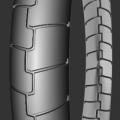Which of these two tyres looks more natural? I mean which one of them is better?
11K Vertices:
vs
36K vertices:
Is there a better way to model a tyre? Single mesh? Cause I want full control on the tyre.
Which of these two tyres looks more natural? I mean which one of them is better?
11K Vertices:
vs
36K vertices:
Is there a better way to model a tyre? Single mesh? Cause I want full control on the tyre.
wait whats ur point? one of them goes inwards and one outwards? well it depends on the tire. do what the reference is doing.
also polycount dont really matter, unless its for a game. but if its for a game when ur MILES above the budget already.
One tire design looks to be geared towards dry weather conditions and more grip the other for wet conditions and greater water displacement. Technically your second design is closer to what real world designs would be.
Best is to follow real tyre design … depending the year of the Harley you are doing …
Some example of Dunlop harley davidson ones .
The new 2018 Dunlop for Harley:
I am exactly doing that. But none of my methods are working. I am modeling a patch of the pattern and using array and empty as offset. There are all sorts of problem. The artifacts. Choppy roundness. Here is what I mean:
Look how blocky this tyre looks. It is not smooth. Creating extruded bumps is not hard, but creating inward bumps, individually, is very hard.
Any help here will be appreciated.
I am making Harley davidson, and nearly 99% of them have treads inward like in the first pic (which is my actually second attempt). But the problem is the choppiness and the very sharp edges. I don’t know how to make it look more like a tyre.
I just wanted to know if my polycount is way over for a tyre in general.
But my second image was actually my first attempt and is something I don’t want. I want the bumps to be inward as with most harleys.
just add some bevel on edges or use subsurf to get more rounded edges
I did some tires that has like 100 Kverts
depends on how well defined you need your tire model
if depth of tracks are not too great you could use a UV map too
happy bl

blend file: Tyre.blend (163 KB)
Mostly used inset, after that the corners at t-junctions were carefully beveled and manually cleaned up.
Hey, post wires of your mesh so we can have a look, like you did in previous posts. That said, are you using edge crease and/or edge-split modifier ? Also there is a ‘trick’ to getting stuff like that looking really good. I’ll post the link below, but it basically involves using a high poly mesh (not the same one your working on), ‘shrink wrap’ modifier, possibly ‘data transfer’ modifier (prob optional in this case), and vertex groups or group. Check out the video, it should be alot of help.
https://cgmasters.net/free-tutorials/advanced-subsurf-modeling-techniques-to-avoid-pinching
It take some times for end with a good result. theres tutorial that you can find on youtube,
I have done some high poly some long time ago …
creating the thread ( including the side part ), array, then curve … ( subsurf in last ) but they are absolutely far of been low poly (
double post…
Bevel makes the edges more sharp. ![]()
That’s great! I will try it. Thanks!
I know those edges that are too close to it are causing the issue. But if I get rid of them, I get black areas near those bumps.
This is new model:
check the area marked with faint red color. I want to get rid of those pinching.
This method doesn’t work with inward bumps. Also those are many array object working together. The kind of tyre I am modeling has big strips of bumps. ![]()
Hey, Ya you are correct about edge loops too close together, also way too much geometry for just a ‘patch’ of tire. It is best to start very simple then add to it (sub D) modelling. That is why edge crease, proper beveling and edge split modifier are your friends. You could easily get rid of 40% of those verts, if you got rid of those edge (verts) on the leading edge and trailing edge of that V it would eliminate that.
Also make sure you don’t have any ‘doubles’ or even overlapping geometry…